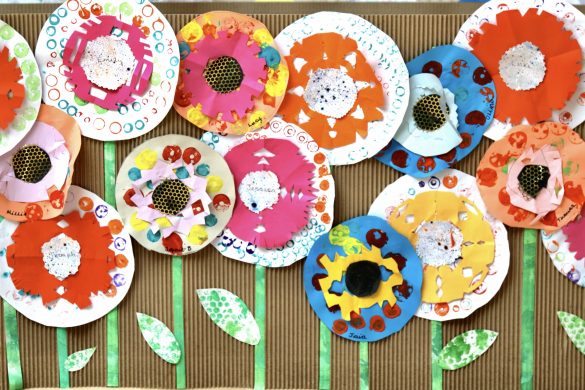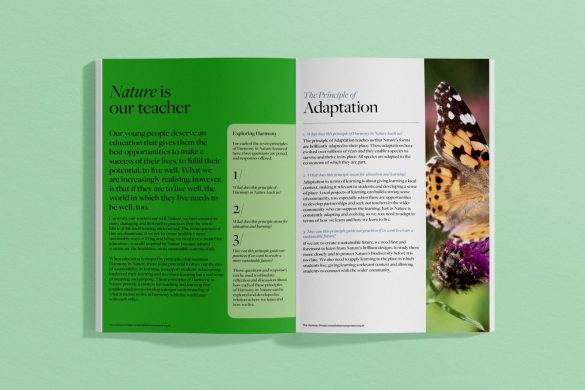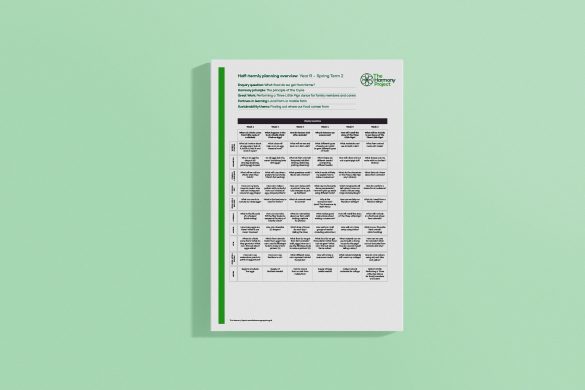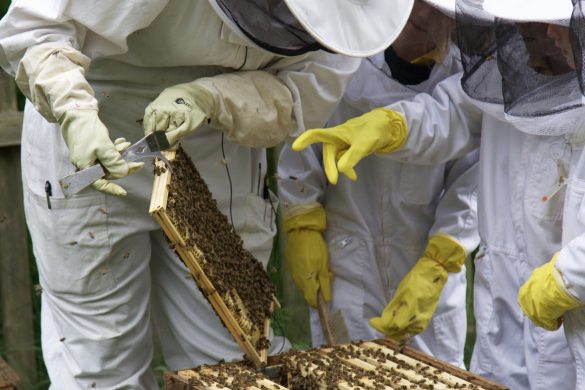EYFS Harmony book list

Books to introduce and explore Nature's principles of Harmony in the EYFS
As every educator knows, there’s nothing quite like the power of a good book to spark children’s imaginations, prompt questions, start discussion and bring concepts, characters and contexts to life.
With this in mind, we’ve created this book list, which is packed with engaging and beautifully presented texts for EYFS practitioners to explore with the children they work with. We’ve selected these books because they can be used to provide a ‘way in’ to the principles of Harmony in Nature that we work with at The Harmony Project. You can use them as the basis for learning or discussion that has the principles of Harmony at its core, or even to refresh your reading corner.
For each text we’ve chosen, we’ve included an overview of the book itself, along with ideas about how it can be used to explore one of our principles of Harmony.
THE PRINCIPLE OF INTERDEPENDENCE
The Trouble with Dragons
by Debi Gliori
Written entirely in verse, this clever book explores how a growing population of dragons eventually learns to live more sustainably by making better use of the resources they depend upon and working together. Debi Gliori’s gentle humour and quirky illustrations offer a wonderful opportunity to introduce early discussion about environmental challenges, including habitat loss and climate change, and – most importantly – about what we can do about them. The dragon cities in the book provide a great stimulus for junk modelling to create more sustainable homes for these colourful, irresistible creatures.
Emma’s Lamb
by Kim Lewis
A short, beautifully illustrated book which follows the relationship that develops between a lamb and a child until the lamb is reunited with her mother. The bonds between the lamb and the child, and the lamb and the ewe, which permeate this touching story, provide a fantastic starting point for conversations about the ways in which we rely on one another. A great text to support emotional development and understanding of our world, as well as factual learning about life on a farm and exploring the story of our food.
The World Came to My Place Today
by Dr Jo Readman
George learns from his Grandpa about the plants from all over the world that we depend upon in our daily lives – and not just for things to eat and drink. The cheerful, mixed media illustrations, which combine drawings with photographs of fruits, grasses and plants, support children’s growing awareness of what we use in the natural world and can stimulate discussion about our duty of care to nature. Olfactory and tactile sensory isolation games (blindfolded) in which children identify fruits and other plant-based objects from their scent and feel would support this text beautifully.
THE PRINCIPLE OF DIVERSITY
Where is the Green Sheep?
by Mem Fox and Judy Horacek
This fun, rhyming story takes very young children on a sheep-filled adventure! Throughout the pages of the book, children search for the green sheep that’s hiding in a diverse flock which includes the sun sheep, the band sheep and the moon sheep. With its use of simple, repetitive language, this light-hearted text works brilliantly as an introduction to early poetry and opens up discussions about diversity, acceptance and uniqueness. It can also be used to support early numeracy by encouraging children to count the sheep in the images or using small sheep toys.
All are Welcome
by Alexandra Penfold & Suzanne Kaufman
A bright and uplifting celebration of cultural diversity with colourful, inclusive illustrations. Featuring the repeated phrase “All are welcome here”, this short text works particularly well as a stimulus for settling-in sessions at school, encouraging children to consider what makes each of us special and unique, and supporting personal, social emotional development. The rhyming language supports early literacy learning and, as the book features some of the different types of bread eaten around the world, there’s plenty of scope for tactile, gustatory and olfactory sensory experiences to support children’s exploration of the book – and bread-making!
My HAIR
by Danielle Murrell Cox
This short picture book is a glorious exploration of how diverse hair can be! The bold imagery of different types of hair and different hairstyles, accompanied by simple text, is perfect for prompting discussion and understanding about how we are similar and how we are different. There is scope for a range of follow-on activities based on texture and colour, and involving descriptive vocabulary as a link to early literacy.
Millie’s Marvellous Hat
by Satoshi Kitamura
Millie visits a local hat shop after school one day and starts to imagine all the different kinds of hats that people might wear – and that she might wear – in different situations. Children will marvel at Millie’s mind-stretching imagination as they enjoy this quirky, beautifully illustrated book. This text works particularly well as an introduction to early literacy storytelling and as a stimulus to child-led creative art activities such as designing and making hats! Children may also enjoy discussing what their own imaginary hat would look like and how it compares to the hats other children might imagine for themselves.
Monkey Puzzle
by Julia Donaldson
Readers accompany a young monkey as he tries to find his mother with the help of a butterfly. His attempts to describe his mother lead him to a variety of jungle animals until he is reunited with his mum! This text works very well as an introduction to early literacy activities including asking and answering questions, and describing objects or animals for others to guess, as well as a stimulus for investigating the features of different animals and using this knowledge to group them.
THE PRINCIPLE OF THE CYCLE
The Shortest Day
by Susan Cooper
This stunning book celebrating the winter solstice and Yuletide season is based on a poem about ritual and community at this time of year. The illustrations are enchanting and there is a strong message of hope for peace that we carry into the future. A magical text that supports drama, dance and music activities with a wintery theme, as well as creative art activities that celebrate light during the dark months, such as bright chalking on black paper.
It Starts with a Seed
by Laura Knowles
This beautifully illustrated non-fiction text brings to life the principle of the Cycle by following the journey of a sycamore seed from its germination through to its life as an adult tree. Children will enjoy learning about the development of the tree and about the animals and living things which it supports (there is a link here to the principle of Interdependence). At the end of the book, the tree releases its own seeds and the cycle starts again. Works particularly well as a stimulus for non-fiction early writing, especially leaflets and information books.
Worms
by Susie Williams
This beautifully illustrated non-fiction book provides children with a great introduction to the principle of the Cycle. Worms are great recyclers, and children will love learning about the amazing role they play in our gardens, breaking down fallen leaves, twigs and dead creatures to enrich the soil, which in turn supports the health of the plants that grow in it. This text works particularly well as a stimulus for discussions about the cycle of the garden through the seasons, and how we can learn from worms about becoming better at recycling ourselves.
A Year Around the Great Oak
by Gerda Muller
When Anna and Benjamin stay with their relatives in the countryside, they discover a 300-year-old giant oak growing in a local woodland. The tree captures their imaginations and they return to it time and time again, learning more with each visit about how it changes through the seasons and about some of the threats the oak faces. A great starting point for conversations about the cycle of the seasons and the life cycle of trees, or for nature walks to find out more about the trees – and other natural treasures – found in the local area.
Grow it!
by Child’s Play
This simple book, with its brightly coloured illustrations, follows one young boy as he helps with tasks in the garden. Young readers learn alongside him as he plants seeds, finds out how to care for the seedlings and maturing plants, and finally harvests and enjoys the vegetables he has helped to grow. A delightful, purposeful text that evokes a sense of collaboration and community and is a great starting point for planting projects on any scale, from sowing ‘cress heads’ to tending for a class vegetable patch – and, of course, tasting activities at harvest time!
THE PRINCIPLE OF OF ADAPTATION
I am Cat
by Jackie Morris
A domestic cat dreams about its distant cat cousins around the world, which are brought to life by the exquisite illustrations in this captivating book. At the end of the text, a summary of cats around the world can be used to start discussions about how each cat is adapted to its habitat. There are opportunities for learning linked to early mathematics in the form of grouping activities, and the text works well as a stimulus for drama, face painting and costume-making. It could also be used to explore the principle of Diversity.
Say Goodbye, Say Hello
by Cori Doerrfeld
The activities that two friends enjoy through the seasons, from building snowmen, to splashing in puddles and spotting butterflies, introduce young children to the themes of change and adaptation. The biggest change comes at the end of the book, when one of the friends moves away, and each must adapt to this new situation. This short text supports transitional work that is ideal for settling-in sessions and encouraging a growth mindset to help children maintain a positive outlook in the face of change.
We Build Our Homes
by Laura Knowles
This delightful book provides a great introduction to the principle of Adaptation, inviting young readers to explore how different animals build their homes to best match their habitat. The text works well as a stimulus for discussion about the homes people around the world live in and how these are adapted to different needs in different places. There are opportunities to learn about different building materials and to design and create homes for different animals or people.
Stellaluna
by Janell Cannon
Separated from her mother, Stellaluna the fruit bat is adopted by a family of birds. She discovers, however, that her new family has very different habits and she must adapt to life as a bird until she is reunited with her bat family. The two pages of facts about bats at the end of the book can be used to prompt further discussion about adaptation and how these fascinating creatures are adapted to their environment. This text lends itself particularly well to early maths activities involving grouping nocturnal and diurnal animals.
THE PRINCIPLE OF ONENESS
The Sea of Tranquillity
by Mark Haddon
A captivating story about how the moon landings of 1969 captured one child’s imagination. The tale allows children to see the Moon – which is so much a part of our world – from another perspective. This magical, short text offers a range of opportunities to support early non-fiction writing, including posters, and provides a great jumping-off point for learning about the night sky, the solar system and where we fit within it. Children can draw the Moon by tracing or drawing around circle templates, supporting pincer grip development in preparation for early writing.
Animals in the Sky
by Sara Gillingham
A captivating introduction to stargazing that teaches children about some of the animal constellations visible in the night sky and provides a natural connection to the principle of Interdependence. Written as a series of riddles, younger children are invited to use the clues in the text and in the images to identify six of the most recognisable animal constellations. There’s a great opportunity for children to recreate the constellations using a ruler to join the dots, plus links to early mathematics in space, shape and measurement.
THE PRINCIPLE OF HEALTH
My Daddy is a Pretzel: Yoga for Parents and Kids
by Baron Baptiste
A fun, practical introduction to yoga that can be used to support children’s learning about the principle of Health. Children will enjoy stretching their minds as well as their bodies as they learn about mindfulness and concentration alongside different yoga poses. With simple instructions to follow, these activity cards help to develop listening and attention skills, as well as promoting physical activity and well-being. There are also suggestions for whole-class meditation moments, which students and teachers alike are bound to benefit from!
The Go-Away Bird
by Julia Donaldson and Catherine Rayner
This funny, touching story helps young children explore the idea that our relationships with those around us help us to feel well, and that we have a role to play in helping others to feel well, too. The Go-Away bird wants to be left alone until she finds herself in trouble and discovers the benefits of friendship. Children will delight in the rhyming language, beautiful illustrations and the clever twist in the story as the bird lets down her guard and welcomes friends in. Can be used to inspire social and emotional role play scenarios.
The Ugly Vegetables
by Grace Lin
A young girl asks her mother why their garden full of ‘ugly’ Chinese vegetables looks so different to the flower-filled gardens of their friends. The twist in this heart-warming tale comes at the end, when the aroma of the delicious Chinese soup her mother makes with the harvest from their vegetable patch lures their neighbours, and the soup is shared around. Provides a wonderful stimulus for vegetable growing projects and cooking activities using vegetables, and prompts discussion about the importance of fresh produce in a healthy diet.



